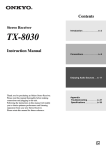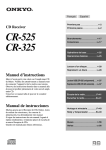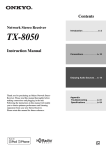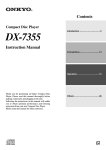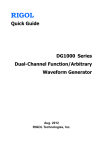Download ONKYO CS-555
Transcript
CD Receiver CR-555 CR-555DAB Instruction Manual Getting Started .......................... 2 Connections ............................ 13 Basic Operations .................... 16 Playing CDs ............................. 18 iPod / iPhone Playback ........... 22 Using USB interface ................ 23 Thank you for purchasing an Onkyo CD receiver. Please read this manual thoroughly before making any connections and plugging it in. Following the instructions in this manual will enable you to obtain optimum performance and listening enjoyment from your new CD receiver. Please retain this manual for future reference. Listening to the Radio ............ 25 Advanced Operations ............. 30 Miscellaneous .......................... 31 En WARNING: TO REDUCE THE RISK OF FIRE OR ELECTRIC SHOCK, DO NOT EXPOSE THIS APPARATUS TO RAIN OR MOISTURE. CAUTION: TO REDUCE THE RISK OF ELECTRIC SHOCK, DO NOT REMOVE COVER (OR BACK). NO USER-SERVICEABLE PARTS INSIDE. REFER SERVICING TO QUALIFIED SERVICE PERSONNEL. WARNING AVIS RISK OF ELECTRIC SHOCK DO NOT OPEN RISQUE DE CHOC ELECTRIQUE NE PAS OUVRIR The lightning flash with arrowhead symbol, within an equilateral triangle, is intended to alert the user to the presence of uninsulated “dangerous voltage” within the product’s enclosure that may be of sufficient magnitude to constitute a risk of electric shock to persons. The exclamation point within an equilateral triangle is intended to alert the user to the presence of important operating and maintenance (servicing) instructions in the literature accompanying the appliance. Important Safety Instructions 1. 2. 3. 4. 5. 6. 7. 8. 9. 10. 11. Read these instructions. Keep these instructions. Heed all warnings. Follow all instructions. Do not use this apparatus near water. Clean only with dry cloth. Do not block any ventilation openings. Install in accordance with the manufacturer’s instructions. Do not install near any heat sources such as radiators, heat registers, stoves, or other apparatus (including amplifiers) that produce heat. Do not defeat the safety purpose of the polarized or grounding-type plug. A polarized plug has two blades with one wider than the other. A grounding type plug has two blades and a third grounding prong. The wide blade or the third prong are provided for your safety. If the provided plug does not fit into your outlet, consult an electrician for replacement of the obsolete outlet. Protect the power cord from being walked on or pinched particularly at plugs, convenience receptacles, and the point where they exit from the apparatus. Only use attachments/accessories specified by the manufacturer. PORTABLE CART WARNING 12. Use only with the cart, stand, tripod, bracket, or table specified by the manufacturer, or sold with the apparatus. When a cart is used, use caution when S3125A moving the cart/apparatus combination to avoid injury from tip-over. 13. Unplug this apparatus during lightning storms or when unused for long periods of time. 14. Refer all servicing to qualified service personnel. Servicing is required when the apparatus has been damaged in any way, such as power-supply cord or plug is damaged, liquid has been spilled or objects have fallen into the apparatus, the apparatus has been exposed to rain or moisture, does not operate normally, or has been dropped. 2 15. Damage Requiring Service Unplug the apparatus from the wall outlet and refer servicing to qualified service personnel under the following conditions: A. When the power-supply cord or plug is damaged, B. If liquid has been spilled, or objects have fallen into the apparatus, C. If the apparatus has been exposed to rain or water, D. If the apparatus does not operate normally by following the operating instructions. Adjust only those controls that are covered by the operating instructions as an improper adjustment of other controls may result in damage and will often require extensive work by a qualified technician to restore the apparatus to its normal operation, E. If the apparatus has been dropped or damaged in any way, and F. When the apparatus exhibits a distinct change in performance this indicates a need for service. 16. Object and Liquid Entry Never push objects of any kind into the apparatus through openings as they may touch dangerous voltage points or short-out parts that could result in a fire or electric shock. The apparatus shall not be exposed to dripping or splashing and no objects filled with liquids, such as vases shall be placed on the apparatus. Don’t put candles or other burning objects on top of this unit. 17. Batteries Always consider the environmental issues and follow local regulations when disposing of batteries. 18. If you install the apparatus in a built-in installation, such as a bookcase or rack, ensure that there is adequate ventilation. Leave 20 cm (8") of free space at the top and sides and 10 cm (4") at the rear. The rear edge of the shelf or board above the apparatus shall be set 10 cm (4") away from the rear panel or wall, creating a fluelike gap for warm air to escape. Precautions 1. Recording Copyright—Unless it’s for personal use only, recording copyrighted material is illegal without the permission of the copyright holder. 2. AC Fuse—The AC fuse inside the unit is not userserviceable. If you cannot turn on the unit, contact your Onkyo dealer. 3. Care—Occasionally you should dust the unit all over with a soft cloth. For stubborn stains, use a soft cloth dampened with a weak solution of mild detergent and water. Dry the unit immediately afterwards with a clean cloth. Don’t use abrasive cloths, thinners, alcohol, or other chemical solvents, because they may damage the finish or remove the panel lettering. 4. Power WARNING BEFORE PLUGGING IN THE UNIT FOR THE FIRST TIME, READ THE FOLLOWING SECTION CAREFULLY. AC outlet voltages vary from country to country. Make sure that the voltage in your area meets the voltage requirements printed on the unit’s rear panel (e.g., AC 230 V, 50 Hz or AC 120 V, 60 Hz). The power cord plug is used to disconnect this unit from the AC power source. Make sure that the plug is readily operable (easily accessible) at all times. For models with [POWER] button, or with both [POWER] and [ON/STANDBY] buttons: Pressing the [POWER] button to select OFF mode does not fully disconnect from the mains. If you do not intend to use the unit for an extended period, remove the power cord from the AC outlet. For models with [ON/STANDBY] button only: Pressing the [ON/STANDBY] button to select Standby mode does not fully disconnect from the mains. If you do not intend to use the unit for an extended period, remove the power cord from the AC outlet. 5. Preventing Hearing Loss Caution Excessive sound pressure from earphones and headphones can cause hearing loss. 6. Batteries and Heat Exposure Warning Batteries (battery pack or batteries installed) shall not be exposed to excessive heat as sunshine, fire or the like. 7. Never Touch this Unit with Wet Hands—Never handle this unit or its power cord while your hands are wet or damp. If water or any other liquid gets inside this unit, have it checked by your Onkyo dealer. 8. Handling Notes • If you need to transport this unit, use the original packaging to pack it how it was when you originally bought it. • Do not leave rubber or plastic items on this unit for a long time, because they may leave marks on the case. • This unit’s top and rear panels may get warm after prolonged use. This is normal. • If you do not use this unit for a long time, it may not work properly the next time you turn it on, so be sure to use it occasionally. • When you’ve finished using this unit, remove all discs and turn off the power. 9. Installing this Unit • Install this unit in a well-ventilated location. • Ensure that there’s adequate ventilation all around this unit, especially if it’s installed in an audio rack. If the ventilation is inadequate, the unit may overheat, leading to malfunction. • Do not expose this unit to direct sunlight or heat sources, because its internal temperature may rise, shortening the life of the optical pickup. • Avoid damp and dusty places, and places subject to vibrations from loudspeakers. Never put the unit on top of, or directly above a loudspeaker. • Install this unit horizontally. Never use it on its side or on a sloping surface, because it may cause a malfunction. • If you install this unit near a TV, radio, or VCR, the picture and sound quality may be affected. If this occurs, move this unit away from the TV, radio, or VCR. 10. To Obtain a Clear Picture—This unit is a hightech, precision device. If the lens on the optical pickup, or the disc drive mechanism becomes dirty or worn, the picture quality may be affected. To maintain the best picture quality, we recommend regular inspection and maintenance (cleaning or worn part replacement) every 1,000 hours of use depending on the operating environment. Contact your Onkyo dealer for details. 11. Moisture Condensation Moisture condensation may damage this unit. Read the following carefully: Moisture may condense on the lens of the optical pickup, one of the most important parts inside this unit. • Moisture condensation can occur in the following situations: – The unit is moved from a cold place to a warm place. – A heater is turned on, or cold air from an air conditioner is hitting the unit. – In the summer, when this unit is moved from an air conditioned room to a hot and humid place. – The unit is used in a humid place. 3 Precautions—Continued • Do not use this unit when there’s the possibility of moisture condensation occurring. Doing so may damage your discs and certain parts inside this unit. If condensation does occur, unplug the power cord and leave the unit for two to three hours in the room temperature. This unit contains a semiconductor laser system and is classified as a “CLASS 1 LASER PRODUCT”. So, to use this model properly, read this Instruction Manual carefully. In case of any trouble, please contact the store where you purchased the unit. To prevent being exposed to the laser beam, do not try to open the enclosure. CAUTION: CLASS 1M VISIBLE AND INVISIBLE LASER RADIATION WHEN OPEN. DO NOT VIEW DIRECTLY WITH OPTICAL INSTRUMENTS. THIS PRODUCT UTILIZES A LASER. USE OF CONTROLS OR ADJUSTMENTS OR PERFORMANCE OF PROCEDURES OTHER THAN THOSE SPECIFIED HEREIN MAY RESULT IN HAZARDOUS RADIATION EXPOSURE. The label on the right is applied on the rear panel. 1. This unit is a CLASS 1 LASER PRODUCT and employs a laser inside the cabinet. 2. To prevent the laser from being exposed, do not remove the cover. Refer servicing to qualified personnel. For British models Replacement and mounting of an AC plug on the power supply cord of this unit should be performed only by qualified service personnel. IMPORTANT The wires in the mains lead are coloured in accordance with the following code: Blue: Neutral Brown: Live As the colours of the wires in the mains lead of this apparatus may not correspond with the coloured markings identifying the terminals in your plug, proceed as follows: The wire which is coloured blue must be connected to the terminal which is marked with the letter N or coloured black. The wire which is coloured brown must be connected to the terminal which is marked with the letter L or coloured red. IMPORTANT The plug is fitted with an appropriate fuse. If the fuse needs to be replaced, the replacement fuse must approved by ASTA or BSI to BS1362 and have the same ampere rating as that indicated on the plug. Check for the ASTA mark or the BSI mark on the body of the fuse. If the power cord’s plug is not suitable for your socket outlets, cut it off and fit a suitable plug. Fit a suitable fuse in the plug. For European Models Declaration of Conformity We, ONKYO EUROPE ELECTRONICS GmbH LIEGNITZERSTRASSE 6, 82194 GROEBENZELL, GERMANY declare in own responsibility, that the ONKYO product described in this instruction manual is in compliance with the corresponding technical standards such as EN60065, EN55013, EN55020 and EN61000-3-2, -3-3. GROEBENZELL, GERMANY K. MIYAGI ONKYO EUROPE ELECTRONICS GmbH 4 Features Amplifier • • • • • • • WRAT (Wide Range Amplifier Technology) Symmetrical Designed Power Amplifier Circuitry 2 Digital Inputs (1 Optical/1 Coaxial) 3 Audio Inputs and 1 Output Optimum Gain Volume Circuitry 3 Stage Inverted Darlington Amplifier Design Subwoofer Pre Out VLSC™ is a trademark of Onkyo Corporation. Windows Media, and the Windows logo are trademarks, or registered trademarks of Microsoft Corporation in the United States and/or other countries. CD Player • • • • • • Plays CDs, MP3/WMA CDs, CD-Rs and CD-RWs 25 Track Programming 2 Repeat Mode (Track/Full) 3 Play Modes (Normal/Random/Memory) VLSC (Vector Linear Shaping Circuitry) 192 kHz/24-bit D/A Converters iPod / iPhone • iPod®/iPhone® Digital Direct Connection via USB USB Interface • MP3/WMA compatible • 3 Repeat Modes (Track/Full/1 Folder) • 3 Play Modes (Normal/Random/1 Folder) iPhone, iPod, iPod classic, iPod nano, iPod shuffle, and iPod touch are trademarks of Apple Inc., registered in the U.S. and other countries. “Made for iPod” and “Made for iPhone” mean that an electronic accessory has been designed to connect specifically to iPod or iPhone, respectively, and has been certified by the developer to meet Apple performance standards. Apple is not responsible for the operation of this device or its compliance with safety and regulatory standards. Please note that the use of this accessory with iPod or iPhone may affect wireless performance. Tuner & Other • • • • • • • • • 40 AM/FM Presets (CR-555) 40 FM/40 DAB Presets (CR-555DAB) Sleep Timer Sleep&Charge Function Phase-Matching Bass Boost System Auto Standby Function Headphone Jack Aluminium Front Panel RI-Dock Compatible Remote Control (iPod/iPhone Control Capable) • Aluminium Volume Knob 5 Supplied Accessories Make sure you have the following accessories: Remote controller (RC-849S) and two batteries (AAA/R03) (Note for China: The battery for the remote controller is not supplied for this unit.) Indoor FM antenna (CR-555) Indoor FM/DAB antenna (CR-555DAB) AM loop antenna (CR-555) Power cord * In catalogs and on packaging, the letter at the end of the product name indicates the color. Specifications and operations are the same regardless of color. Before Using the CD receiver Installing the Batteries Using the Remote Controller When you operate the remote controller, point it at the CD receiver’s remote control sensor, as shown below. CD receiver Batteries (AAA/R03) Note: • If the remote controller doesn’t work reliably, try replacing the batteries. • Don’t mix new and old batteries or different types of batteries. • If you intend not to use the remote controller for a long time, remove the batteries to prevent damage from leakage or corrosion. • Expired batteries should be removed as soon as possible to prevent damage from leakage or corrosion. 6 5 x. pro p A m Remote control sensor Note: • The remote controller may not work reliably if the CD receiver is subjected to bright light, such as direct sunlight or inverter-type fluorescent lights. Keep this in mind when installing. • If another remote controller of the same type is used in the same room, or the CD receiver is installed close to equipment that uses infrared rays, the remote controller may not work reliably. • Don’t put anything, such as a book, on the remote controller because the buttons may be pressed inadvertently, thereby draining the batteries. • The remote controller may not work reliably if the CD receiver is installed in a rack behind colored glass doors. Keep this in mind when installing. • The remote controller will not work if there’s an obstacle between it and the CD receiver’s remote control sensor. Contents Getting Started Listening to the Radio Important Safety Instructions .................................... 2 Precautions ............................................................... 3 Features .................................................................... 5 Supplied Accessories................................................ 6 Before Using the CD receiver ................................... 6 Installing the Batteries ........................................... 6 Using the Remote Controller ................................. 6 Getting to Know the CD receiver............................... 8 Front Panel............................................................ 8 Display................................................................... 8 Rear Panel ............................................................ 9 Remote Controller ............................................... 10 Disc Notes............................................................... 11 Listening to the Radio.............................................. 25 Tuning into Radio Stations .................................. 25 Presetting FM Stations Automatically (Auto Preset)..................................................... 25 Changing radio wave intensity (CR-555DAB) ..... 25 Presetting AM/FM Stations Manually .................. 26 Selecting Preset Stations .................................... 26 Receiving RDS .................................................... 26 Copying Presets .................................................. 27 Erasing Presets ................................................... 27 Naming Presets ................................................... 28 Changing AM Frequency Step ............................ 28 Listening to DAB Digital Radio (CR-555DAB) ..... 29 Connections Advanced Operations Connecting Antennas.............................................. 13 Connecting Speakers.............................................. 14 Connecting Other Components............................... 14 About Connections .............................................. 14 Connecting an Onkyo RI Dock (Remote Interactive Dock) ................................ 15 Connecting the Power Cord .................................... 15 Custom Setup.......................................................... 30 Setting Common Preferences ............................. 30 Miscellaneous Troubleshooting....................................................... 31 Specifications .......................................................... 34 Basic Operations Basic Operations..................................................... 16 Turning On the CD receiver ................................ 16 Adjusting the Volume .......................................... 16 Selecting the Input Source .................................. 16 Adjusting the Tone .............................................. 16 Setting the Display Brightness ............................ 17 Using Headphones.............................................. 17 Using the Sleep Timer......................................... 17 Muting the Sound ................................................ 17 Playing CDs Playing CDs ............................................................ 18 Displaying CD Information................................... 18 Selecting Files (MP3/WMA) ................................ 18 Displaying MP3/WMA Information....................... 19 Memory Playback................................................ 20 Random Playback ............................................... 20 Repeat Playback ................................................. 20 Setting MP3/WMA Preferences........................... 21 iPod / iPhone Playback iPod / iPhone Playback ........................................... 22 Playing an iPod/iPhone via USB ......................... 22 iPod/iPhone Playback via Onkyo Dock ............... 22 Displaying Music File Information........................ 22 Using USB interface Using USB interface................................................ 23 Playing Music Files on a USB Flash Drive .......... 23 7 Getting to Know the CD receiver Front Panel a c d e b f g h i jk l m n The page numbers in parentheses show where you can find the main explanation for each item. a Display (8) b VOLUME control This control is used to adjust the volume of the CD receiver to “Min”, “1” through “41”, “Max”. h TONE button Used to adjust the tone. i Open/Close [0] button (18) j RETURN button (21) c 8ON/STANDBY button (16) k Stop [2] button (18) d USB port Connect an iPod/iPhone or USB flash drive to this port. e Phones jack (17) l MENU/ENTER jog dial Used as the Previous/Next button and the MENU/ENTER button. It is also used for various settings. f Disc tray (18) m Remote control sensor (6) g INPUT button Used to select the input source. n Play/Pause [1/3] button (18) Display a b ef g h d c i j k l m n o p The page numbers in parentheses show where you can find the main explanation for each item. 8 a Play and pause 1/3 indicators (18) c DIGITAL, ANALOG indicators b Tuning indicators (25) AUTO indicator TUNED indicator AM indicator (CR-555) FM STEREO indicator DAB indicator (CR-555DAB) RDS indicator (European models) d Playback mode indicators (20, 24) 1FOLDER indicator MEMORY indicator RANDOM indicator ~ indicator ~1 indicator Getting to Know the CD receiver—Continued e SLEEP indicator (17) k DIRECT indicator (16) f Message area l S.BASS indicator (16) g USB indicator (23) m MUTING indicator (17) h FOLDER indicator (18) n DISC, TOTAL indicators (18) i FILE indicator (18) o REMAIN indicator (18) j TRACK indicator (18) p Auto Standby (ASb) indicator (30) Rear Panel (CR-555) a g (CR-555DAB) b cd h e f j i a SPEAKERS f AC INLET b u REMOTE CONTROL This u (Remote Interactive) jack can be connected to an u jack on Onkyo RI Dock. g SUBWOOFER PRE OUT This jack is for connecting a powered subwoofer. c AUX IN This stereo minijack (ø3.5mm) is for connecting an audio source. d LINE IN These analog audio inputs are for connecting Onkyo RI Dock and cassette deck, etc. h LINE OUT This analog audio output is for connecting a recorder such as cassette deck. i DIGITAL IN COAXIAL and OPTICAL j DAB/FM ANTENNA (CR-555DAB) See pages 13–15 for connection information. e FM ANTENNA AM ANTENNA (CR-555) 9 Getting to Know the CD receiver—Continued Remote Controller a b c The page numbers in parentheses show where you can find the main explanation for each item. n o d a On/Standby [8] button (16) b DISPLAY button Used to change the information shown on the display. c DIMMER button (17) d INPUT SELECTOR buttons (16) e Pause [3] button (18) e f p f Previous/Next [7]/[6] and [e PRESET]/[PRESET r] buttons (18, 26) q g Rewind/Fast Forward [5]/[4] and [e TUN]/[TUN r] buttons (18, 25) g h Arrow [!]/["]/[#]/[$] and ENTER buttons i MENU button Used with various functions and settings for selecting. h i j TONE/BAL button Used to adjust the tone. r k MEMORY button (20) s l RANDOM button (20) j t k l u m Number buttons Used to select tracks and radio presets. n Open/Close [0] button (18) o SLEEP button (17) p Play [1] button (18) q Stop [2] button (18) r RETURN button (21, 22) m s VOLUME [q/w] buttons (16) t MUTING button (17) v u REPEAT button (20) v D.TUN/CLEAR button (25, 28) 10 Disc Notes Precautions for Playback Compact discs (CDs) with the following logo on the label surface can be used. Do not use discs designed for purposes other than audio, such as CD-ROMs for PC use. Abnormal noise could damage the speakers or amplifier. * This CD receiver supports CD-R and CD-RW discs. Note that some discs may not playback because of the disc characteristics, scratches, contamination or the recording state. A disc recorded with an audio CD record will not playback unless it is finalized. Never use discs which have a special shape (such as hearts or octagons). These types of discs could jam and damage the CD receiver. Note: • A disc recorded with a recorder or personal computer may not play in some cases. (Cause: Disc’s characteristics, damaged or dirty disc, dirt on player’s lens, dew condensation, etc.) • A disc recorded on a personal computer may not play because of the application settings or environment. Record the disc with the proper format. (Contact the application maker for details.) • A disc with insufficient storage capacity may not playback properly. Playback of MP3 Discs • Only MP3 files with the extension “.MP3” or “.mp3” are supported. • This CD receiver supports files recorded in MPEG 1 Audio Layer 3 (32-320 kbps), with the sampling rate of 32/44.1/48 kHz. • Variable bitrates (VBR) between 32 kbps and 320 kbps are supported. The time information during VBR playback may not display correctly. Playback of WMA Discs CD Playback with Copy-control Function Some audio CDs with copy-control function do not comply with official CD standards. These are special discs and cannot be played with this CD receiver. Playback of MP3 and WMA Discs MP3 and WMA files recorded on a CD-R/CD-RW can be played with this CD receiver. • Use discs which have been recorded following the ISO9660 Level 2 file system. (The supported directory depth is eight levels, the same as ISO9660 Level 1) Discs recorded with the hierarchical file system (HFS) cannot be played. • Up to 99 folders (including the root folder), and up to 499 folders (including root) and files can be recognized and played. • Always close the disc tray. • WMA stands for “Windows Media® Audio”, an audio compression technology developed by Microsoft Corporation USA. • Only WMA files with the extension “.WMA” or “.wma” are supported. • Encode the WMA file with an application approved by Microsoft Corporation USA. The file may not playback correct if encoded with an unapproved application. • Variable bitrates (VBR) between 32 kbps and 192 kbps (32/44.1/48 kHz) are supported. • Copyright-protected WMA files cannot be played back. • WMA Pro, Lossless and Voice are not supported. 11 Disc Notes—Continued Handling Discs Caring for Discs Hold discs by the edge, or by the center hole and edge. Avoid touching the playback surface (surface with nothing printed on it). If the disc is dirty, the CD receiver will have a hard time reading signals, and the audio quality may drop. If the disc is dirty, gently wipe off fingerprints and dust with a soft cloth. Lightly wipe from the center outwards. To remove stubborn dust or dirt, wipe the disc with a soft cloth dampened with water, and then dry it with a dry cloth. Do not use cleaning spray for analog records or antistatic agents, etc. Never use volatile chemicals such as benzine or paint thinner as they can impregnate the disc surface. Label surface (printed surface) Playback surface Do not attach paper or stickers, or write on the playback or label surface of the disc. Take care not to scratch or damage the disc. Precautions for Rental Discs Do not use discs with residue from cellophane tape, rental discs with labels which are peeling off, or discs with decorative labels. This type of disc could get stuck in the CD receiver, or could damage the CD receiver. Precautions for Inkjet Printable Discs Do not leave a CD-R/CD-RW having a label printed with an inkjet printer in the CD receiver for a long time. The disc could get stuck in the CD receiver, or could damage the CD receiver. Remove the disc from the CD receiver when not being played, and store it in a case. A freshly printed disc will stick easily, and should not be played immediately. 12 Connecting Antennas This section explains how to connect the supplied FM antenna, AM loop antenna (CR-555), and DAB antenna (CR555DAB). The CD receiver won’t pick up any radio signals without an antenna connected, so you must connect the antenna to use the tuner. (CR-555) Insert the plug fully into the jack. Push. Insert wire. Release. Assembling the AM loop antenna Caution: • Be careful not to injure yourself when using thumbtacks. Thumbtacks, etc. AM loop antenna (supplied) Indoor FM antenna (supplied) (CR-555DAB) Insert the plug fully into the jack. Caution: • Be careful not to injure yourself when using thumbtacks. • If you cannot achieve good reception with the supplied indoor FM antenna, try a commercially available outdoor FM antenna instead. • (CR-555) If you cannot achieve good reception with the supplied indoor AM loop antenna, try using it with a commercially available outdoor AM antenna. • Once the CD receiver is ready for use, you’ll need to tune into an AM radio station and adjust the position of the AM antenna to achieve the best possible reception. • Keep the antenna as far away as possible from the CD receiver, TV, speaker cables, and power cords. 13 Connecting Speakers Connecting Your Speakers • Connect the right speaker to the CD receiver’s right (R) SPEAKERS terminals. Connect the left speaker to the left (L) SPEAKERS terminals. • Connect the positive (+) terminal on each speaker to the corresponding positive (+) terminal on the CD receiver. Connect the negative (–) terminal on each speaker to the corresponding negative (–) terminal on the CD receiver. Use the red wires to connect the positive (+) terminals. Right speaker Speaker cable Left speaker ■ Screw-type speaker terminals Strip 12 to 15 mm of insulation from the ends of the speaker cables, and twist the bare wires tightly, as shown. 12 to 15 mm • Connect only speakers with an impedance of between 4 and 16 ohms. Connecting a speaker with a lower impedance may damage the speaker. • Be careful not to short the positive and negative wires. Doing so may damage the CD receiver. • Do not connect both speaker cables to the same L or R terminals (Fig. 1). Do not connect more than two speaker terminals to each speaker (Fig. 2). Red wires Fig. 1 Fig. 2 LINE INPUT LINE INPUT Powered subwoofer Connecting Other Components About Connections • Before making any connections, read the manuals supplied with your other components. • Don’t connect the power cord until you’ve completed and double-checked all connections. • Push plugs in all the way to make good connections (loose connections can cause noise or malfunctions). • To prevent interference, keep audio cables away from power cords and speaker cables. 14 Right! Wrong! Note: • Do not put anything on top of the CD receiver, as it may interfere with proper ventilation. Caution: • To prevent shutter damage, hold the optical plug straight when inserting and removing. Connecting Other Components—Continued Connecting an Onkyo RI Dock (Remote Interactive Dock) The following diagram shows how to connect an optional Onkyo RI Dock (Remote Interactive Dock). Connect either of them. R L ANALOG AUDIO OUT ON /ST AN DB Y ST AN RI Dock DB Y iPo d PC UN SYN SY C/ NC Digital Media Transport What can you do with u? • Connecting an Onkyo RI Dock to the CD receiver with an u cable allows you to control the RI Dock with the CD receiver’s remote controller. In addition, when playback is started on the RI Dock, the CD receiver will automatically select it as the input source. • To use u, you must connect the Onkyo RI Dock to the CD receiver with an u cable (If you connect the Onkyo RI Dock to LINE IN, you also need to connect it with an analog audio cable.). On the RI Dock, set the RI MODE switch to “HDD” or “HDD/DOCK”. See the RI Dock’s instruction manual for details. • Set the CD receiver’s Input Display to “DOCK” (see page 30). Connecting the Power Cord Note: • Before connecting the power cord, connect all of your speakers and components. • Turning on the CD receiver may cause a momentary power surge that might interfere with other electrical equipment on the same circuit. If this is a problem, plug the CD receiver into a different branch circuit. • Never disconnect the power cord from the CD receiver while the other end is still plugged into a wall outlet. Doing so may cause an electric shock. Always disconnect the power cord from the wall outlet first, and then the CD receiver. • Do not use a power cord other than the one supplied with the CD receiver. The supplied power cord is designed exclusively for use with the CD receiver and should not be used with any other equipment. 1 Connect the supplied power cord to the CD receiver’s AC INLET. To AC wall outlet 2 Plug the power cord into an AC wall outlet. 15 Basic Operations This manual describes the procedure for using the remote controller, unless otherwise specified. Turning On the CD receiver To turn on the CD receiver, press the On/Standby [8] button on the remote controller. Press the On/Standby [8] button again to set the CD receiver to Standby. You can also use the [8ON/STANDBY] button on the CD receiver. Tip: • For details on power management settings, see “ASb (Auto Standby)” (see page 30), “SleepCharge” (see page 30). Adjusting the Volume To adjust the volume, use the VOLUME [q/w] button. You can also use the [VOLUME] control on the CD receiver. Selecting the Input Source To select the input source, press the remote controller’s [INPUT SELECTOR] button. On the CD receiver, press the [INPUT] button repeatedly. The input sources are selected in the following order. (CD receiver) → → CD → LINE1 → LINE2 → AUX IN AM ← FM ← USB ← COAXIAL ← OPTICAL DAB (Remote controller) 16 → LINE1 → LINE2 AUX IN → [LINE]: [DIGITAL]: OPTICAL ↔ COAXIAL [TUNER]: FM ↔ AM DAB Adjusting the Tone 1 Press the [TONE] button repeatedly. Setting will change in the following orders: Bass, Treble, Balance, PM.Bass, Direct 2 Use the Arrow [#]/[$] buttons to adjust the tone. Bass, Treble –3 to 0 to +3 in 1 steps. (The default value is 0.) Balance L7 to 0 to R7 in 1 steps. (The default value is 0.) PM.Bass (Phase Matching Bass) From the warm low notes produced by a cello to the deep frequencies of electronic music, a good compact audio system should be able to deliver plenty of bass resonance. While traditional enhancement systems effectively boost low-frequency sound, they are often prone to the effects of phase shifting, which can overwhelm mid-range frequencies and muddy the sound. Our Phase-Matching Bass Boost technology effectively preserves mid-range clarity-allowing vocals and strings to shine-while maintaining a smooth, powerful bass response at all volume levels. When the Phase Matching Bass function is on, the S.Bass indicator appears on the display. On Off (default) Note: • If the PM.Bass function is set to “On”, “Direct” function cannot be selected. You need to set the PM.Bass function to “Off” to enable “Direct” function. Direct When the Direct function is on, the tone controls are bypassed, so you can enjoy a pure sound. The DIRECT indicator appears on the display. On Off (default) Note: • If the Direct function is set to “On”, the “Bass”, “Treble” and “PM.Bass” functions cannot be selected. You need to set the Direct function to “Off” to enable those settings. Basic Operations—Continued Setting the Display Brightness You can adjust the brightness of the CD receiver’s display. 1 Press the [DIMMER] button repeatedly to cycle through the following patterns: • Normal brightness. • Dim brightness. • Dimmer brightness. Using Headphones Turn down the volume, then connect your stereo headphones to the Phones minijack. The speakers output no sound while the headphones are connected. Muting the Sound To mute the output of the CD receiver, press the remote controller’s [MUTING] button. The MUTING indicator appears on the display. To unmute the CD receiver, press the [MUTING] button again. Tip: While the CD receiver is muted: • Turning the [VOLUME] control on the CD receiver or pressing the VOLUME [q/w] buttons on the remote controller will unmute the CD receiver. • If you turn the CD receiver off, the next time you turn it on, the CD receiver will be unmuted. Using the Sleep Timer With the sleep timer, you can set the CD receiver so that it automatically turns off after a specified period. Press the [SLEEP] button repeatedly to select the required sleep time. With the [SLEEP] button, you can set the sleep time from 90 to 10 minutes in 10 minute increments. When the sleep timer has been set, the SLEEP indicator appears on the display. The sleep time appears on the display for about 5 seconds, then the previous display reappears. Checking the Remaining Sleep Time To check the remaining sleep time, press the [SLEEP] button. Note that if you press the [SLEEP] button while the sleep time is being displayed, you’ll shorten the sleep time by 10 minutes. Canceling the Sleep Timer To cancel the sleep timer, press the [SLEEP] button repeatedly until the SLEEP indicator disappears. 17 Playing CDs 1 Press the Open/Close [0] button to open the disc tray. 2 Place the CD on the tray with the label-side facing up. Place 8 cm CDs in the center of the tray. 3 To start playback, press the Play [1] button. The disc tray closes and playback starts. The Play 1 indicator appears. To stop playback: Press the Stop [2] button. To pause playback: Press the Pause [3] button. The Pause 3 indicator appears. To resume playback, press the Pause [3] or Play [1] button again. To Fast-Forward or Fast-Reverse During playback or while playback is paused, press and hold the Fast Forward [4] button to fast forward, or the Reverse [5] button to fast reverse. To remove the CD: Press the Open/Close [0] button to open the disc tray. • Audio CD Display “DISC TOTAL” lights up. Total number of tracks • MP3/WMA CD Display Total playing time Disc name or Format Displaying CD Information During playback, press the remote controller’s [DISPLAY] button repeatedly to display the following CD information. • Elapsed time • REMAIN Lights up while the remaining track time is being displayed. • TOTAL REMAIN Lights up while the remaining disc time is being displayed. The total time is more than 99 minutes and 59 seconds, “– –:– –” is displayed. Selecting Files (MP3/WMA) There are two modes for selecting files (MP3/WMA files): Navigation mode and All Folder mode. In Navigation mode, you can select files (MP3/WMA files) by navigating through the folder hierarchy, moving in and out of folders and subfolders. In All Folder mode, all folders appear at the same level, making it easy to select folders regardless of the hierarchy. In this manual, MP3/WMA files are referred to as files. Likewise, folders (directories) are referred to as folders. Note: • If you don’t select a specific MP3/WMA file or folder for playback, all of the MP3/WMA files on the disc will be played in numerical order starting with file #1. Selecting Files in Navigation Mode This mode can only be used while playback is stopped. Total number of folders Total number of files 1 While playback is stopped, press the Stop [2] button. The CD receiver enters Navigation mode and “[Root]” appears on the display. 2 Press the Play [1] button. The name of the first folder one level down from root appears on the display. If the disc contains no folders, the first file name appears. 3 Use the Previous and Next [7]/[6] buttons to select other folders and files at the same level. Selecting Tracks To return to the beginning of the track currently playing, press the Previous [7] button. Press the Previous [7] button repeatedly to select earlier tracks. • While playback is stopped, pressing the Previous [7] button will select the previous track. Press the Next [6] button to select subsequent tracks. 18 Playing CDs—Continued 4 5 To access files or subfolders inside another folder, select the folder, and then press Play [1] button. Use the Previous and Next [7]/[6] buttons to select the files and subfolders within that folder. To move up a level, press the Pause [3] button. To start playback, press the [ENTER] or Play [1] button. Tip: • You can also use the Stop [2] button and [MENU/ENTER] jog dial on the CD receiver. Note: • The behavior of Stop [2] on the CD receiver can be set from “STOP KEY” (see page 21). Selecting Files in All Folder Mode This mode can only be used while playback is stopped. 1 2 3 4 While playback is stopped, press the Pause [3] button. The CD receiver enters All Folder mode, and “1” appears on the display. Use the Previous and Next [7]/[6] buttons to select the other folders. To play the first file in the selected folder, go to Step 4. To access the files inside the folder, press the Play [1] button. To select the files in the folder, repeat the step 2. To select another folder, press the Pause [3] button again, and then use the Previous and Next [7]/[6] buttons to select it. To start playback, press the [ENTER] or Play [1] button. Tip: • You can also use the Stop [2] button (press and hold) and [MENU/ENTER] jog dial on the CD receiver. Note: • The behavior of Stop [2] on the CD receiver can be set from “STOP KEY” (see page 21). ■ Cancelling Navigation or All Folder Mode To cancel Navigation mode or All Folder mode while selecting MP3/WMA files, return to upper hierarchy and press the Stop [2] button. ■ To Select Folders and Files by Number Use the number buttons as shown in the examples below to enter folder numbers. (Audio CD) For example, to specify file #8, press [8]. To specify file #34, press [>10], [3], and [4]. To specify file #134, press [>10], [1], [3], and [4]. Tip: • If a folder contains more than 99 files, single- and double-digit file numbers must be preceded by zeros. (MP3/WMA CD) Press [>10] once to select the files, twice to select the folders and enter the numbers. Displaying MP3/WMA Information You can display various information about the MP3/WMA file currently playing, including ID3 tags such as title, artist name, and album name. During playback, press the [DISPLAY] button repeatedly to display the following MP3/WMA information. • Elapsed time If the elapsed time is more than 99 minutes and 59 seconds, “– –:– –” is displayed. • File name • Folder name • Title name (if ID3 tag present) • Artist name (if ID3 tag present) • Album name (if ID3 tag present) • Sampling rate and bit rate Note: • If a file or folder name contains any characters that cannot be displayed, an underscore will be displayed in place of those characters. Alternatively, you can set the CD receiver so that names containing such characters are displayed as “File_n” or “Folder_n”, “n” being the file or folder number (see page 21). 19 Playing CDs—Continued Memory Playback With memory playback, you can create a playlist of up to 25 tracks. This mode can only be used while playback is stopped. With random playback, all of the tracks on the disc are played in random order. This mode can only be used while playback is stopped. Press the [RANDOM] button. The RANDOM indicator appears. 1 Press the [MEMORY] button. The MEMORY indicator appears. 2 Use the Previous and Next [7]/[6] buttons to select the first track you want to add to the playlist, and then press the Play [1] button. Repeat this step to add additional tracks to the playlist. You can also use the number buttons on the remote controller to select tracks. Cancelling Random Playback • To cancel random playback, press the [RANDOM] button. • Random playback is cancelled when you press the Open/Close [0] button to open the disc tray, or turn off the CD receiver. To select MP3/WMA files for memory playback: In Navigation mode, use steps 1-4 on pages 18, 19. In All Folder mode, use steps 1-3 on page 19. • You can add up to 25 tracks to the playlist. If you try to add more, the message “Memory Full” appears. With repeat playback, you can play an entire CD repeatedly, play one track repeatedly, or combine it with memory playback to play the playlist repeatedly, or random playback to play all of the tracks on the disc in random order repeatedly. 3 To start memory playback, press the Play [1] button. Selecting Other Tracks During Memory Playback To select other playlist tracks during memory playback, use the remote controller’s Previous and Next [7]/[6] buttons. Checking What’s on the Playlist To check what tracks are on the playlist, with playback stopped, use the Fast Reverse and Fast Forward [5]/[4] buttons to scroll through the playlist. Removing Tracks from the Playlist • While memory playback is stopped, press the [CLEAR] button. Each press removes the last track from the playlist. Cancelling Memory Playback • To cancel Memory playback, press the [MEMORY] button. • The playlist will be deleted when you cancel memory playback, select random playback, press the Open/Close [0] button to open the disc tray, or turn off the CD receiver. 20 Random Playback Repeat Playback Press the [REPEAT] button repeatedly until the ~ or ~1 indicator appears. Repeat-1 playback can’t be combined with memory playback, random playback. Cancelling Repeat Playback • To cancel repeat playback, press the [REPEAT] button repeatedly until both the ~ and ~1 indicators disappear. • Repeat playback is cancelled when you press the Open/Close [0] button to open the disc tray, or turn off the CD receiver. Playing CDs—Continued Setting MP3/WMA Preferences With the MP3/WMA preferences, you can change the way MP3/WMA file information is displayed and the way MP3/WMA CDs are played. This mode can only be used while playback is stopped. 1 Press the [MENU] button, and then use the Arrow [!]/["] buttons to select “MP3 Setting”. 2 3 Press [ENTER]. 4 5 Press [ENTER]. 6 Press [ENTER]. When the preference has been set, “Complete” appears on the display. Use the Arrow [!]/["] buttons to select the preference you want to change. The preferences are explained in the next column. Use the Arrow [#]/[$] buttons to select the preference’s options. Tip: • To cancel the procedure at any point, press the [MENU] button. • Press the [RETURN] button to return to the previous menu. • You can also use the [MENU/ENTER] jog dial on the CD receiver. Preferences BAD NAME This preference determines whether or not file and folder names that contain undisplayable characters are replaced with “File_n” or “Folder_n”, “n” being the file or folder number. When set to “Not”, displayable characters are displayed and underscore characters are used in place of any undisplayable characters. For ID3 tags, underscore characters are used in place of undisplayable characters regardless of this preference. Replace Not (default) ID3 VER.1 This preference determines whether or not version 1.0/1.1 tags are read and displayed. When set to “Not Read”, version 1.0/1.1 ID3 tags will not be displayed. Read (default) Not Read ID3 VER.2 This preference determines whether or not version 2.2/2.3/2.4 tags are read and displayed. When set to “Not Read”, version 2.2/2.3/2.4 ID3 tags will not be displayed. Read (default) Not Read CD EXTRA This preference applies to CD Extra discs and determines whether music in the audio session or MP3/WMA files in the data session are played. Audio (default) MP3 JOLIET This preference applies to MP3/WMA CDs in Joliet format and determines whether the CD receiver reads the SVD data or treats the disc as an ISO 9660 disc. Normally, this preference doesn’t need to be changed. SVD (Supplementary Volume Descriptor) supports long file and folder names and characters other than letters and numbers. Use SVD (default) ISO9660 HIDE NUMBER This preference determines whether or not the numbers at the beginning of file and folder names are hidden. When you create an MP3/WMA CD on a personal computer, you cannot normally determine the playback order of the files. However, if you number the MP3/WMA files in order, starting with 01, 02, 03, and so on, they will play in that order. If you don’t want these numbers to appear on the display, choose “Enable”. Disable: (default) Enable: The file and folder name, including numbers, will be displayed as is. The file and folder name will be displayed but numbers will be hidden. STOP KEY This preference determines how the Stop [2] button on the CD receiver works. When the “Navigation” option is selected, pressing the Stop [2] button once selects Navigation mode. When the “All Folder” option is selected, pressing the Stop [2] button once selects All Folder mode. • When the “Disable” option is selected, CD receiver does not enter Navigation or All Folder mode by pressing the Stop [2] button. Navigation (default) All Folder Disable 21 iPod / iPhone Playback Playing an iPod/iPhone via USB iPod/iPhone Playback via Onkyo Dock • Before using the Onkyo Dock components, update your iPod/iPhone with the latest software, available from the Apple web site. • Set the CD receiver’s Input Display to “DOCK”. For details, refer to “Sel Change” (see page 30). Compatible iPod/iPhone models Made for: iPod touch (1st, 2nd, 3rd and 4th generation), iPod classic, iPod nano (2nd, 3rd, 4th, 5th and 6th generation), iPhone 4S, iPhone 4, iPhone 3GS, iPhone 3G, iPhone Note: • With the following iPod/iPhone, the charging mode does not work when it is connected in standby mode. iPod touch (1st, 2nd and 3rd generation), iPod nano (2nd generation), iPhone 3GS, iPhone 3G, iPhone 1 2 Press the [USB] button. 3 Use the Arrow [!]/["] buttons to select a folder, and then press [ENTER] to open it. 4 Use Arrow [!]/["] buttons to select a music file, and press [ENTER] or the Play [1] button to start playback. Connect the USB cable that comes with the iPod/iPhone to the USB port on the front of the CD receiver. The message “iPod” appears. Tip: • When connecting your iPod/iPhone with a USB cable, we recommend you use an official USB cable from Apple Inc. Tip: • You can also use the [INPUT] button and [MENU/ENTER] jog dial on the front panel. • The [RETURN] button is used as a menu button. • For the basic button operation and play mode, refer to “Playing Music Files on a USB Flash Drive” (see page 23). With some iPod/iPhone models and generations, certain buttons may not work as expected. 22 1 Use the [INPUT SELECTOR] button to select “DOCK”. 2 To start playback, press [ENTER] or the Play [1] button. To pause playback: Press the [3] button. To resume playback, press the [3] button again. To Fast-Forward or Fast-Reverse During playback, press and hold the Fast Forward [4] button to fast forward, or the Reverse [5] button to fast reverse. Selecting Tracks Press the Previous/Next [7]/[6] buttons to select the previous or next track. Tip: • For the basic play mode, refer to “Playing Music Files on a USB Flash Drive” (see page 23). With some iPod/iPhone models and generations, certain buttons may not work as expected. • The [RETURN] button is used as a menu button. • The Arrow [!]/["] buttons are used to scroll up and down the list and file. Note: • To adjust the volume, use the VOLUME [q/w] button. You can also use the [VOLUME] control on the CD receiver. • If you use your iPod/iPhone with any other accessories, iPod/iPhone playback detection may not work. Displaying Music File Information You can display various information about the music files currently playing. During playback, press the [DISPLAY] button repeatedly to display the following music file information. • Title name • Artist name • Album name Using USB interface The CD receiver can play back MP3 and WMA files that have been stored on USB flash drives and MP3 players. 1 Use the [USB] buttons to select “USB”. The USB indicator lights. • When no USB flash drive is connected, “No USB” will be displayed. • When there is no MP3, WMA or AAC file in the USB flash drive, “No USB” will be displayed. 2 To start playback, press the Play [1] button. Playback will begin with the top file in the folder organization. Supported Audio File Formats For USB flash drive playback, the CD receiver supports the following music file formats. ■ About FAT • Supports FAT16 and 32. • Supports up to 499 files per folder. • Supports up to 499 folders. ■ MP3 decoder • Supports MPEG Audio 1, 2 and 2.5. • Supports Layer 1, 2 and 3. • Supports sample rates 8 k, 16 k, 32 k, 11.025 k, 22.05 k, 44.1 k, 12 k, 24 k and 48 kHz. • Supports bit rates 8 to 320 kbps and VBR (Variable Bit Rate). ■ WMA decoder • Supports WMA Ver. 9 standard. • Does not support DRM. • Supports sample rates 8 k, 16 k, 32 k, 11.025 k, 22.05 k, 44.1 k, 12 k, 24 k and 48 kHz. • Supports bit rates 5 to 384 kbps and VBR (Variable Bit Rate). ■ AAC decoder • Supports MPEG4 AAC-LC encoded by iTunes. • Does not support DRM. • Supports sample rates 8 k, 16 k, 32 k, 11.025 k, 22.05 k, 44.1 k, 12 k, 24 k and 48 kHz. • Supports bit rates 8 to 320 kbps and VBR (Variable Bit Rate). Playing Music Files on a USB Flash Drive This section explains how to play music files on a USB flash drive. Connect a USB flash drive as shown below. To stop playback: Press the Stop [2] button. To pause playback: Press the Pause [3] button. The Pause 3 indicator appears. To resume playback, press the Pause [3] button again. Display during Stop USB indicator Total number of folders Total number of files Note: • In general, playback of USB flash drive music files is a repeating playback. When all music files have been played, playback will repeat from the top music file in the folder organization. The type of repeat playback can be selected (see page 24). Selecting Music files To return to the beginning of the music file currently playing, press the Previous [7] button. Press the Previous [7] button repeatedly to select previous file. • While playback is stopped, pressing the Previous [7] button will select the previous file. Press the Next [6] button to select next file. Selecting Music files in other folders USB flash drive 1. Press the [<10] button to display the current folder name. The folder name will flash. 2. To select the previous folder, press the Previous [7] button. To select the next folder, press the Next [6] button. 3. To start playback, press the Play [1] button. Playback will start from the first file in the selected folder. 23 Using USB interface—Continued Note: • Do not connect the CD receiver’s USB port to a USB port on your computer. Music on your computer cannot be played through the CD receiver in this way. • Operation with all USB flash drives including the ability to power them is not guaranteed. • Do not connect your USB flash drive via a USB hub. The USB flash drive must be connected directly to the CD receiver’s USB port. • If the USB flash drive contains a lot of data, the CD receiver make take a while to read it. Resume Playback After playback has been stopped, when the Play [1] button is pressed to begin playback again, it will resume playback from the beginning of the file in which it stopped. Cancelling Resume Playback While playback is stopped, press the Stop [2] button. “ResumeClear” will appear on the display. Resume will be cleared even if the following operations are performed: • another music file is selected; • the power cord is unplugged; • the USB flash drive is unplugged during playback. Random Playback With random playback, all of the music files on the USB flash drive are played in random order. This mode can only be used while playback is stopped. 1 Press the [RANDOM] button. The RANDOM indicator appears. 2 To start random playback, press the Play [1] button. Press the [REPEAT] button repeatedly to select the type of repeat playback. • Repeat playback (default): ~ indicator appears • Repeat-1 playback: Repeats a single selected file. ~1 indicator appears • 1-Folder playback: Repeat playback of all files in a selected folder. ~ and 1FOLDER indicators appear. Note: Repeat-1 or 1-Folder playback can’t be combined with random playback. Displaying Music File Information You can display various information about the MP3, WMA or AAC files currently playing, including ID3 tags such as title, artist name, and album name. During playback, press the [DISPLAY] button repeatedly to display the following music file information. Elapsed time The length of time that the current MP3, WMA or AAC file has been playing (default display). If the elapsed time is more than 99 minutes and 59 seconds, “– –:– –” is displayed. • File name • Folder name • Title name (if ID3 tag present) • Artist name (if ID3 tag present) • Album name (if ID3 tag present) Charging Mode Cancelling Random Playback • To cancel random playback, press the [RANDOM] button. The RANDOM indicator disappears. • Random playback is cancelled when the USB flash drive is removed or the CD receiver is set to Standby. Select the type of Repeat Playback When playing back USB flash drive music files, all files on the USB flash drive will be played according to repeat playback (~ indicator is already lit up). The type of Repeat playback can be selected. 24 If you set the “SleepCharge” function to “On”, you can supply power to the USB device (mobile device) connected to the CD receiver. If you connect the USB device (mobile device) while the CD receiver is in the standby mode, charging will start and the message “Charging” appears. The same applies to the case when the CD receiver enters the standby mode by pressing the On/Standby [8] button. Tip: • If you press any of the On/Standby [8] button, Open/Close [0] button and Play [1] button, charging will stop. Note: • For details of the charging mode, refer to “SleepCharge” (see page 30). Listening to the Radio Tuning into Radio Stations Band Frequency (Actual display depends on country) Tuning into weak stereo FM stations If the signal from a stereo FM station is weak, it may be impossible to get good reception. In this case, switch to Manual Tuning mode and listen to the station in mono. Presetting FM Stations Automatically (Auto Preset) With the Auto Preset function, you can automatically preset all of the FM radio stations available in your area in one go. Presets make it easy to select your favorite stations and eliminate the need to tune the radio manually each time you want to change stations. The Auto Preset function does not preset AM radio stations (see page 26). Auto Preset Caution! Any existing presets will be deleted when the Auto Preset function is run. 1 Press the [TUNER] button repeatedly to select “AM” or “FM”. 2 Press the [ENTER] button repeatedly. The AUTO indicator appears. 1 Press the [TUNER] button repeatedly to select “FM”. • Auto Tuning Mode The AUTO indicator appears and stereo radio reception is possible. 2 Press the [MENU] button, and then use the Arrow [!]/["] buttons to select “TunerSetting”. 3 4 Press [ENTER]. 5 Press [ENTER]. A message requesting confirmation appears. To cancel the Auto Preset function at this point, press the [MENU] button. 6 To start the Auto Preset function, press [ENTER]. Up to 40 stations can be preset and presets are stored in frequency order. • Manual Tuning Mode The AUTO indicator is not displayed and radio reception will be in mono. 3 Use the TUN [e]/[r] buttons to tune into a station. In Auto tuning mode, once a station is found, tuning stops automatically. Radio frequency can be changed in 0.05 MHz steps for FM and 9 kHz or 10 kHz steps for AM. In Manual Tuning mode, the frequency stops changing when you release the button. Press the button repeatedly to change the frequency one step at a time. Tip: • Press and hold the Play/Pause [1/3] button on the CD receiver to switch between modes. Tuning into stations by frequency You can tune into AM and FM stations directly by entering the appropriate frequency. 1 Press the [TUNER] button repeatedly to select “AM” or “FM”, followed by the [D.TUN] button. 2 Within 8 seconds, use the number buttons to enter the frequency of the radio station. For example, to tune to 87.5 (FM), press [8], [7], [5], [0]. If you have entered the wrong number, you can retry after 8 seconds. Use the Arrow [!]/["] buttons to select “AutoPreset”. Tip: • You can also use the [INPUT] button and [MENU/ENTER] jog dial on the CD receiver. Changing radio wave intensity (CR-555DAB) If the weak radio station is frequently received during Auto Preset/Scan, set the “SearchLevel” setting to “Strong” to receive the strong radio station only. The default setting is “Normal”. 1 Press the [MENU] button, and then use the Arrow [!]/["] buttons to select “TunerSetting”. 2 3 Press [ENTER]. 4 Press [ENTER]. Use the Arrow [!]/["] buttons to select “SearchLevel”. 25 Listening to the Radio—Continued 5 Use the Arrow [#]/[$] buttons to select “Normal” or “Strong”. 6 Press [ENTER]. “Complete” appears on the display. Tip: • You can also use the [MENU/ENTER] jog dial on the CD receiver. Presetting AM/FM Stations Manually With the Preset Write function, you can manually preset individual AM and FM radio stations. You can store a combination of up to 40 of your favorite AM/FM radio stations as presets. 1 Tune into the station that you want to store as a preset. 2 Press the [MENU] button, and then use the Arrow [!]/["] buttons to select “TunerSetting”. 3 4 5 Press [ENTER]. Use the Arrow [!]/["] buttons to select “PresetWrite”. Press [ENTER]. The preset number flashes. To cancel the Preset Write function at this point, press the [MENU] button. 6 Use the Arrow [#]/[$] buttons to select a preset. 7 To store the station, press [ENTER]. If no station has yet been stored to the selected preset, “Complete” appears and the station is stored. If a station has already been stored in the selected preset, the message “OverWrite?” appears. To overwrite the previously stored station, press the [ENTER] button. To not overwrite the previously stored station, press the [MENU] button. Tip: • You can also use the [MENU/ENTER] jog dial on the CD receiver. For European models If the current FM station supports RDS and PS (Program Service Name), the station’s name will be displayed instead of the frequency. 26 Selecting Preset Stations You must store some presets before you can select them (see pages 25 and 26). 1 Use the [TUNER] button to select “AM” or “FM”. The preset you selected the last time you listened to the radio will still be selected. 2 Use the PRESET [e]/[r] buttons to select a preset. You can also use the number buttons to select presets. Tip: • You can also use the [INPUT] button and [MENU/ENTER] jog dial on the CD receiver. Receiving RDS Press the [DISPLAY] button repeatedly to display the following RDS information. • Frequency and preset number • Preset name*1 • Program Service Name • Radio Text (if available) RDS is only available on European models and only in areas where RDS broadcasts are available. What is RDS? RDS stands for Radio Data System and is a method of transmitting data in FM radio signals. It was developed within the European Broadcasting Union (EBU) and many European FM radio stations use it these days. The CD receiver supports and displays the Program Service Name (PS) and Radio Text (RT) types of RDS data. The RDS indicator appears on the display when the CD receiver is tuned to an FM station that supports RDS. Note: • If the signal from an RDS station is weak, RDS data may be displayed intermittently or not at all. • The message “Waiting…” may appear while the RT data is being received. *1 If the selected preset has no name, it will be skipped and the next Program Service Name will be displayed. Listening to the Radio—Continued Copying Presets With the Preset Copy function, you can organize your presets in the order you want. When you copy a preset, its name is also copied. 1 Select the preset you want to copy (see page 26). 2 Press the [MENU] button, and then use the Arrow [!]/["] buttons to select “TunerSetting”. 3 4 Erasing Presets 1 Select the preset you want to erase (see page 26). 2 Press the [MENU] button, and then use the Arrow [!]/["] buttons to select “TunerSetting”. 3 4 Press [ENTER]. 5 Press [ENTER]. A message requesting confirmation appears. To cancel the Preset Erase function at this point, press the [MENU] button. 6 To erase the preset, press [ENTER]. The preset is erased and “Complete” appears on the display. Press [ENTER]. Use the Arrow [!]/["] buttons to select “PresetCopy”. 5 Press [ENTER]. The number of the preset to be copied flashes. 6 Use the Arrow [#]/[$] buttons to select the destination preset. The number of the destination preset flashes. 7 To copy the preset, press [ENTER]. If no station has yet been stored in the destination preset, the station is copied and “Complete” appears. If a station has already been stored in the destination preset, the message “OverWrite?” appears. To overwrite the previously stored station, press [ENTER]. To not overwrite the previously stored station, press the [MENU] button. Use the Arrow [!]/["] buttons to select “PresetErase”. Tip: • You can also use the [MENU/ENTER] jog dial on the CD receiver. Tip: • If you favorite station is stored in preset #5 and you want to make it preset #1, copy preset #5 to preset #1. To keep the station that’s already stored in preset #1, you may want to copy it to an unused preset first. • You can also use the [MENU/ENTER] jog dial on the CD receiver. 27 Listening to the Radio—Continued Naming Presets Space: Enters a space character. Shift*1: Toggles between lower and upper case characters. (Left)/ (Right): Moves the cursor left or right in the Name input area. BS (Back Space)*2: Moves the cursor backward and deletes one character. OK: Confirms your entry. You can name presets for easy identification. The preset name may contain of up to eight characters. 1 Select the preset you want to name (see page 26). 2 Press the [MENU] button, and then use the Arrow [!]/["] buttons to select “TunerSetting”. 3 4 Press [ENTER]. 5 Use the Arrow [!]/["] buttons to select “Name Edit”. Press [ENTER]. The available characters appear. 6 Use the Arrow [!]/["]/[#]/[$] buttons to select a character, and then press [ENTER]. Repeat this step to enter up to 8 characters. 7 When you’ve finished editing the name and want to store it, be sure to use the Arrow [!]/["]/[#]/[$] buttons to select “OK” and then press [ENTER]. If you fail to do this, the name won’t be saved. • The following table shows available characters. Tip: *1 This can also be performed by using the [>10] button. *2 Press the [CLEAR] button to clear all the characters you have input. Changing AM Frequency Step 1 Press the [MENU] button, and then use the Arrow [!]/["] buttons to select “TunerSetting”. 2 3 Press [ENTER]. 4 5 Press [ENTER]. 6 Press [ENTER]. “Complete” appears on the display. Use the Arrow [!]/["] buttons to select “AMFreq.Step”. Use the Arrow [#]/[$] buttons to select “AMStep 9kHz” or “AMStep10kHz”. Tip: • You can also use the [MENU/ENTER] jog dial on the CD receiver. 28 Listening to the Radio—Continued Listening to DAB Digital Radio (CR-555DAB) Press the [TUNER] button repeatedly to select “DAB”. Selecting DAB for the Very First Time The very first time you select DAB, the Auto Scan function automatically scans the DAB Band III for the multiplexes (i.e., stations) available in your area. Once the scanning process is complete, the first station that was detected is selected. Using the Auto Scan Function Manually If a new DAB station is introduced, or you move to a new area, you can run the Auto Scan function again. 1 2 3 4 5 Press the [MENU] button, and then use the Arrow [!]/["] buttons to select “TunerSetting”. Press [ENTER]. Use the Arrow [!]/["] buttons to select “DAB Scan”. Press [ENTER]. Use the Arrow [#] / [$] buttons to select “U.K” or “World Wide”, and then press [ENTER] to start the Auto Scan function. The number of stations found and the scanning progress are shown on the display. Displaying DAB Radio Information Press the [DISPLAY] button repeatedly to display more information about the selected DAB station. 1. DLS (Dynamic Label Segment) When tuned to a station that’s broadcasting DLS text data, the text will scroll across the display. 2. Program Type 3. Bit Rate and Audio Mode 4. Signal Quality 0-59: Poor reception 60-79: Good reception 80-100: Excellent reception 5. Multiplex Name 6. Multiplex Number and Frequency Preferences Use the following functions and settings to set up DAB digital radio. 1 Press the [MENU] button, and then use the Arrow [!]/["] buttons to select “TunerSetting”. 2 3 Press [ENTER]. 4 5 Press [ENTER]. 6 Press [ENTER]. Use the Arrow [!]/["] buttons to select the preference you want to change. Use the Arrow [#]/[$] buttons to select the preference’s options. Tip: • You can also use the [MENU/ENTER] jog dial on the CD receiver. DAB Scan This setting determines which DAB bands are scanned by the Auto Scan function. U.K: Band III (11B-12D) World Wide: Band III (5A-13F) (default) DAB DRC With the DRC (Dynamic Range Control) setting, you can reduce the dynamic range of DAB digital radio so that you can still hear quiet parts even when listening at low volume levels-ideal for listening to the radio late at night when you don’t want to disturb anyone. Off: (default) Low: High: Small reduction in dynamic range. Large reduction in dynamic range. DAB Mode With this setting, you can sort the available stations alphabetically, by active stations, or multiplex. Alphabet: (default) Active ST.: Multiplex: Sort stations alphabetically. Sort by active stations. Receivable stations appear at the top of the list. Stations that cannot be received properly appear at the bottom of the list. Sort stations by multiplex. 29 Custom Setup The common setting for each input selector is explained below. Go through the following steps for setup. Press the [MENU] button, and then use the Arrow [!]/["] buttons to select the preference you want to change. 2 3 Press [ENTER]. 4 Press [ENTER]. Use the Arrow [#]/[$] buttons to select the preference’s options. Tip: • You can also use the [MENU/ENTER] jog dial on the CD receiver. Preferences ASb (Auto Standby) When “Auto Standby” is set to “On”, the CD receiver will automatically enter standby mode if there is no operation for 30 minutes with no audio signal input. The ASb indicator lights up when the Auto Standby function is enabled. On Off Default setting: On (European models), Off (Other models) SleepCharge You can specify how the power is fed to your USB device (mobile device) when the CD receiver is in standby mode. On: (default) Off: If you connect USB device (mobile device), charging will start. “Charging” appears on the display. Your USB device (mobile device) is not charged. Note: • When the “SleepCharge” setting is set to “On”, the power consumption slightly increases in standby mode. • If the iPod/iPhone completely runs out of battery, charging might not work. In that case you need to turn the power on again. 30 → 1 Sel Change When you connect an Onkyo u-capable component, it’s important that you select the input source name that matches the type of component for u to work properly. Before operating this setting, you need to select the input source that you want to set. LINE1, LINE2, OPTICAL, COAXIAL → Setting Common Preferences DOCK Note: • “DOCK” can be selected for the “LINE1”, “LINE2”, “OPTICAL”, “COAXIAL” input selector, but not at the same time. Troubleshooting If you have any trouble using the CD receiver, look for a solution in this section. If you can’t resolve the issue yourself, try resetting the CD receiver before contacting your Onkyo dealer. Note that resetting the CD receiver will delete your radio presets and custom settings. To reset the CD receiver to its factory defaults, turn it on and, while holding down the Stop [2] button, press the [8ON/STANDBY] button. 2 1 HOLD “Clear” will appear on the display and the CD receiver will enter Standby mode. Power Can’t turn on the CD receiver. • Make sure that the power cord is properly plugged into the wall outlet (see page 15). • Unplug the power cord from the wall outlet, wait 5 seconds or more, then plug it in again. The CD receiver turns off unexpectedly. • The CD receiver will automatically enter standby mode when Auto Standby has been set and launches. Audio There’s no sound. • Make sure the correct input source is selected (see page 16). • Make sure the CD receiver is not muted (see page 17). • Make sure the speakers are connected correctly (see page 14). • Check all connections and correct as necessary (see pages 13 to 15). • While headphones are connected, the speakers output no sound (see page 17). The sound quality is not good. • Make sure the speaker cables are connected with the correct polarity (see page 14). • Make sure all audio connecting plugs are pushed in all the way (see page 14). • The sound quality can be affected by strong magnetic fields, such as that from a TV. Try moving any such devices away from the CD receiver. • If you have any devices that emit high-intensity radio waves near the CD receiver, such as a cellular phone that’s being used to make a call, the CD receiver may output noise. • The CD receiver’s precision drive mechanism may emit a faint hissing sound while reading discs during playback or when searching for tracks. You may be able to hear this noise in extremely quiet environments. Audio output is intermittent when the CD receiver is subjected to vibration. • The CD receiver is not a portable device. Use it in a location that’s not subject to shock or vibration. Headphone output is intermittent or there’s no sound. • This may be due to dirty contacts. Clean the headphones plug. See your headphones’ instruction manual for cleaning information. Also, make sure that the headphones cable is not broken or damaged. Audio performance • Audio performance will be at its best about 10 to 30 minutes after the CD receiver has been turned on and had time to warm up. • Using cable ties to bundle audio cables with speaker or power cables may degrade the sound quality, so don’t do it. 31 Troubleshooting—Continued CD Playback Playback jumps. • The CD receiver is being subjected to vibration or the disc is scratched or dirty (see page 11). Can’t add tracks to the playlist for memory playback. • Make sure there’s a disc in the CD receiver. Also, you can only add valid track numbers. For example, if the CD contains 11 tracks, you cannot add track #12. The disc will not play. • Make sure the disc has been loaded correctly, with the label-side facing up. • Check to see if the surface of the disc is dirty (see page 11). • Some CD-R/RW discs may not be playable (see page 11). It takes a long time for playback to start. • It may take the CD receiver a while to read CDs that contain many tracks or files. Can’t Play MP3/WMA/AAC discs. • Use only ISO 9660 Level 1 or Level 2 format discs (see page 11). • The disc has not been finalized. Finalize the disc. • MP3/WMA/AAC files without a “.MP3/.WMA/.AAC” or “.mp3/.wma/.aac” filename extension are not recognized. Tuner Reception is noisy, stereo FM reception suffers from hiss, the Auto Preset function doesn’t preset all stations, when tuned to a stereo FM station. • Check the antenna connections (see page 13). • Change the position of the antenna. • Move the CD receiver away from a nearby TV or computer. • Cars or airplanes can cause noisy interference. • The radio signal will be weakened if it has to pass through a concrete wall before reaching the antenna. • Try setting FM mode to mono (see page 25). • Move power cords and speaker cables as far away as possible from the tuner’s antenna. • When listening to an AM station, noise may be heard when you operate the remote controller. • If none of the above improves the reception, install an outdoor antenna. If a power outage occurs or the power cable is disconnected. • If the preset stations are lost, preset them again (see pages 25, 26). Can’t adjust the frequency of the radio. • Use the Fast Reverse and Fast Forward [5]/[4] buttons to change the frequency of the radio (see page 25). RDS doesn’t work. • • • • The FM station you are tuned to doesn’t support RDS. Install an outdoor FM antenna. Change the position or direction of your outdoor FM antenna. Move the FM antenna as far away as possible from fluorescent lights. Remote Controller The remote controller doesn’t work properly. • • • • • 32 Make sure the batteries have been installed with the correct polarity (+/–) (see page 6). Replace both batteries with new ones. (Do not mix different types of batteries or new and old batteries.) The remote controller is too far away from the CD receiver, or there’s an obstacle between them (see page 6). The CD receiver’s remote control sensor is being subjected to bright light (inverter-type fluorescent light or sunlight). The CD receiver is located behind the glass doors of a audio rack or cabinet. Troubleshooting—Continued USB flash drive Playback Can’t access the music files on a USB flash drive. • Make sure that the USB indicator light is on. If the light is not on, make sure that it is connected correctly and that the USB flash drive is one that is supported (see page 23). • The CD receiver supports USB flash drives that support the USB Mass Storage Class. However, playback may not be possible with some USB flash drives even if they conform to the USB Mass Storage Class. • This CD receiver cannot recognize .WAV or .wav files. • Check that the memory format is FAT16 or FAT32. • USB flash drives with an internal USB hub are not supported. Can’t Play MP3/WMA/AAC Files. • MP3/WMA/AAC files without a “.MP3/.WMA/.AAC” or “.mp3/.wma/.aac” filename extension are not recognized. iPod/iPhone The RI functions don’t work properly. • Make sure the u cable is connected correctly (see page 15). If you connect the Onkyo RI Dock to LINE IN, you also need to connect it with an analog audio cable. • Try resetting your iPod/iPhone. iPod/iPhone connected via USB doesn’t work properly. • Make sure that the iPod/iPhone is connected correctly. • Try resetting your iPod/iPhone. Charging Mode The charging mode does not work. • Make sure the “SleepCharge” function is set to “On”. • Check if the iPod/iPhone completely runs out of battery. If it completely runs out of battery, charging will start after the CD receiver is turned on again. • The CD receiver supports USB flash drives that support the USB Mass Storage Class. However, some of the USB devices that meet the USB Mass Storage Class may not be supplied power. Onkyo is not responsible for damages (such as CD rental fees) due to unsuccessful recordings caused by the unit’s malfunction. Before you record important data, make sure that the material will be recorded correctly. The CD receiver contains a microcomputer for signal processing and control functions. In very rare situations, severe interference, noise from an external source, or static electricity may cause it to lockup. In the unlikely event that this should happen, unplug the power cord, wait at least 5 seconds, and then plug it again. 33 Specifications Amplifier Section General Rated Output Power All channels: Power Supply Power Consumption (European) 2 ch × 22 W at 4 ohms, 1 kHz, 2 ch driven of 0.4% (IEC) Damping Factor 22 (Front, 1 kHz, 8 Ω) THD+N (Total Harmonic Distortion+Noise) 0.4% (1 kHz, 1 W) Input Sensitivity and Impedance (Unbalance) 150 mV/47 kΩ (LINE) Rated RCA Output Level and Impedance 0.15 V/330 Ω (LINE OUT) Frequency Response 10 Hz - 100 kHz/±3 dB (LINE1) Tone Control Characteristics ±6 dB, 80 Hz (BASS) ±8 dB, 10 kHz (TREBLE) +8 dB, 30 Hz (PM.Bass) Signal to Noise Ratio 100 dB (LINE, IHF-A) Speaker Impedance 4 Ω - 16 Ω Tuner Section FM Tuning Frequency Range (European) 87.5 MHz - 108.0 MHz, RDS (Others) 87.5 MHz - 108.0 MHz AM Tuning Frequency Range (CR-555) 522 kHz - 1611 kHz Preset Channel 40 CD Signal Readout Optical non-contact Frequency Response 10 Hz - 20 kHz Audio Dynamic Range 96 dB THD (Total Harmonic Distortion) 0.025% Wow and Flutter Below threshold of measurability Audio Output/Impedance (Analog) 2.0 V (rms)/330 Ω 34 AC 220 - 230 V, 50/60 Hz (CR-555) 72 W (CR-555DAB) 77 W No-sound Power Consumption (CR-555) 30 (USB 1ALoad) W (CR-555DAB) 35 (USB 1ALoad:DAB) W Stand-by Power Consumption (CR-555) 0.26 W (CR-555DAB) 0.27 W Dimensions (W × H × D) 215 mm × 119 mm × 331 mm Weight 4.8 kg ■ Audio Inputs Digital Analog Optical: 1 Coaxial: 1 LINE1, LINE2, AUX ■ Audio Outputs Analog LINE OUT Subwoofer Pre Output 1 Speaker Outputs Main (L, R) Phones 1 (3.5 ø) ■ Others RI USB 1 1 Specifications and features are subject to change without notice. 35 2-1, Nisshin-cho, Neyagawa-shi, OSAKA 572-8540, JAPAN Tel: 072-831-8023 Fax: 072-831-8163 http://www.onkyo.com/ 18 Park Way, Upper Saddle River, N.J. 07458, U.S.A. Tel: 800-229-1687, 201-785-2600 Fax: 201-785-2650 http://www.us.onkyo.com/ Liegnitzerstrasse 6, 82194 Groebenzell, GERMANY Tel: +49-8142-4401-0 Fax: +49-8142-4208-213 http://www.eu.onkyo.com/ The Coach House 81A High Street, Marlow, Buckinghamshire, SL7 1AB, UK Tel: +44-(0)1628-473-350 Fax: +44-(0)1628-401-700 Unit 1033, 10/F, Star House, No 3, Salisbury Road, Tsim Sha Tsui Kowloon, Hong Kong. Tel: 852-2429-3118 Fax: 852-2428-9039 http://www.onkyochina.com/ 1301, 555 Tower, No.555 West NanJin Road, Jin an, Shanghai, China 200041, Tel: 86-21-52131366 Fax: 86-21-52130396 http://www.cn.onkyo.com/ Y1207-2 SN 29401160A (C) Copyright 2012 Onkyo Corporation Japan. All rights reserved. * 2 9 4 0 1 1 6 0 A *




































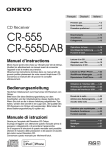
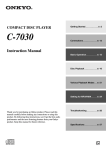

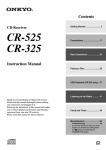
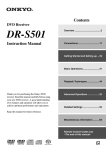
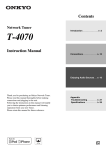
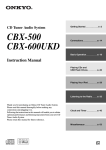

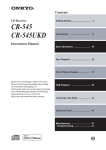
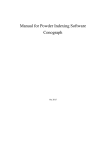
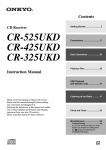
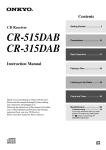
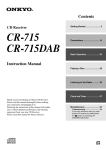
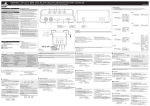
![2 Appuyez sur [ENTER].](http://vs1.manualzilla.com/store/data/006344112_1-5490808b11a7af7cfb484770c0b5963d-150x150.png)
